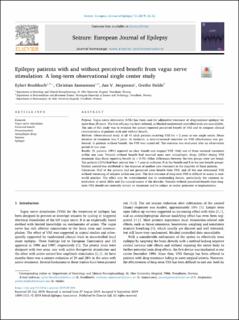Epilepsy patients with and without perceived benefit from vagus nerve stimulation: A long-term observational single center study
Peer reviewed, Journal article
Published version

Åpne
Permanent lenke
https://hdl.handle.net/11250/2763896Utgivelsesdato
2019Metadata
Vis full innførselSamlinger
Sammendrag
Purpose: Vagus nerve stimulaton (VNS) has been used for adjunctive treatment of drug-resistant epilepsy for more than 25 years. The true efficacy has been debated, as blinded randomized controlled trials are unavailable. The aim of this study was to evaluate the patient-reported perceived benefit of VNS and to compare clinical characteristics of patients with and without benefit. Methods: Observational study of all 43 adult patients receiving VNS for > 2 years at one single center. Mean duration of treatment was 9 years. At inclusion, a semi-structured interview on VNS effectiveness was performed. In patients without benefit, the VNS was turned off. The outcome was evaluated after an observation period of one year. Results: 21 patients (49%) reported no clear benefit and stopped VNS. Only one of them resumed treatment within one year. Patients without benefit had received more new antiepileptic drugs (AEDs) during VNS treatment than those reporting benefit (p = 0.05). Other differences between the two groups were not found. Ten patients (23%) had been seizure free > 1 year at inclusion (5 in the benefit and 5 in the non-benefit group). Seizure control was attributed to the response of another new treatment in the majority of these patients. Conclusion: Half of the patients had not perceived clear benefit from VNS, and all but one terminated VNS without worsening of seizures within one year. The true outcome of long-term VNS is difficult to assess in realworld practice. The effect may be overestimated due to confounding factors, particularly the common introduction of novel AEDs and the natural course of the disorder. Patients without perceived benefit from longterm VNS should not routinely remain on treatment and be subject to undue generator re-implantations.